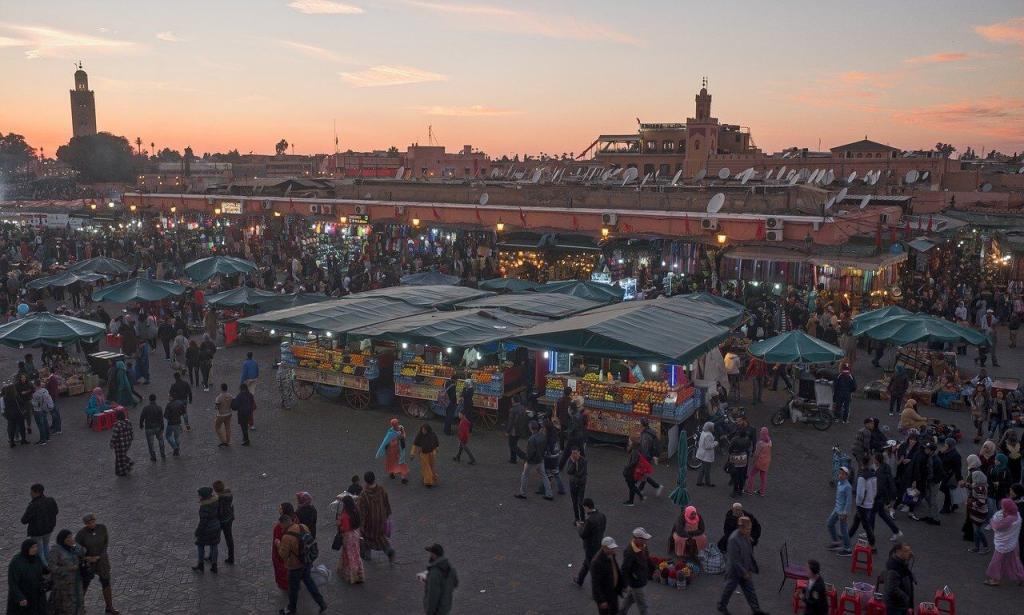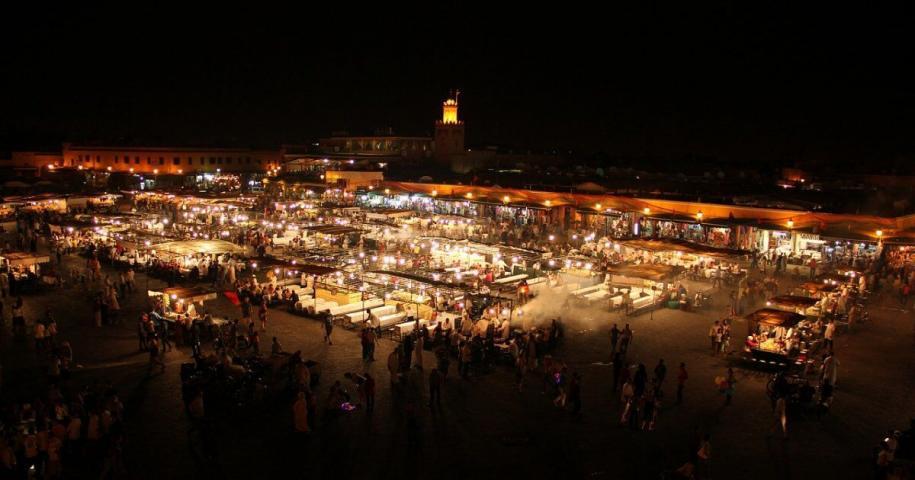Anyone who has been to Marrakech has passed by Jemaa el-Fna Square. Also because, whether you like it or not, you always pass by there. The main hub of the Medina, it is the heart of the city, the beating heart of Marrakech, and the soul of its inhabitants.
Discovering Jemaa el-Fna Square means living an extra-sensory experience. Because visiting this place does not only mean admiring the architectural wonders that form its backdrop. But, it also means letting yourself be carried away by the smells, colors, sounds, the continuous flow of people. And its bizarre artists. Every city has a symbolic place that preserves its identity. Marrakech has found this place in Jemaa el-Fna Square.
You can find this square in the center of the red city and is definitely one of the places you must not miss in Marrakech. Around it, the Medina develops and marks the boundary line between the royal area of the Qasba and the Souq district. On the southwest side stands the imposing Minaret of the Koutoubia, which dominates the background.
Jemaa El-Fna history:
The origin of Jemaa el-Fna Square is rather bizarre, as it was not born with the purpose of sociability, the trademark of today’s square. Or rather, not the sociability we understand nowadays.
Even the origin of its name leaves us perplexed. In fact, it literally means “assembly of the dead”. But we should not be surprised, because this was the place where public executions were carried out from 1050, and where the decapitated heads of all those who dared to rebel against the Sultan were exposed to the people.
Later, in the Saadian era, the square was chosen as the place to build a large mosque, but the project was never completed. Its irregular shape is the greatest testimony of this never-completed project.
The square Today:
Today the square is a continuous swarming of people, stalls, artists, tourists, merchants, and people passing by. Jemaa el-Fna Square is a heart that pulses continuously and with a sustained beat. In order to get to know it fully, you will need to live it fully and participate in its activities, whether they are games, pure entertainment, or related to gastronomy.
In fact, the square is divided in space into precise thematic areas, which in turn is still divided in time according to activities. Therefore, if during the day you will find a colorful and crowded market, in the evening you will be surrounded by dancers, musicians, and storytellers. But it doesn’t end there, because Jemaa el-Fna never rests, and when night comes, tables and benches are set up where you can consume dishes prepared on the spot.
But, let’s analyze in detail what you will find in this decidedly exotic square.

The Stalls:
As we said, the square is divided into very precise thematic areas. During the day you will find all sorts of stalls. So you’ll notice areas reserved for spices, dried fruit, flowers or the expanse of stalls selling fruit juices.
When it gets dark the stalls turn into kiosks that serve an impressive number of dishes, obviously all carefully divided and cataloged. If you like meat go to its specific area and try the Kobane, the traditional mutton, and offal skewers. If, on the other hand, you want to try something even stronger, you can taste the muttonhead.
You can find it at stand 53, which has become the most famous kiosk in the square. In the area dedicated to Berber food, try the Harira, a delicious legume soup that is eaten especially during Ramadan. Also here there is no lack of dishes for the more daring. In fact, you can taste the soup of snails with spices. Finally, if what you are looking for are fish dishes go to the area dedicated to seafood, where you can enjoy an excellent mix of fried fish.
The Actors of the Jemaa El-Fna Square:
Jemaa el-Fna Square at sunset becomes a kaleidoscope of artists and speakers. This particular moment of the day made UNESCO declare it an oral and intangible heritage of humanity. A way to safeguard the moment, the moment, situations that can only happen in this place.
At sunset, you will see thousands of people come out of nowhere, each with their own way of showing off. The most moving are the Berber speakers, with a tradition handed down only orally, represent the last bastion of a way that no longer exists. Note the funny water sellers, with their brass bowls, offer water to the Berber travelers of the Atlas.
Everywhere you’ll see dancers, snake charmers, Henna tattoo artists, and even horsemen. Around them are the Halqa, circles of spectators that form around the actors. A unique spectacle in the world, which Jemaa el-Fna Square jealously preserves.
Jemaa el-Fna in Popular Culture:
Jemaa el-Fna Square has also inspired many artists. In fact, in this place, writers, poets, actors, and directors have discovered an authentic world to which they have remained deeply fascinated.
Jemaa el-Fna in Literature:
Western men have always considered Marrakech as an extremely exotic place, and Jemaa el-Fna has contributed in an important way to this conception. Let’s think, for example, of Elias Canetti, the Bulgarian writer and Nobel Prize winner, who in his “Voices from Marrakech” goes to the city square and, seeing the artists and scribes, wonders about the true meaning of his art.
Luciano Bianciardi, on the other hand, in 1968 makes a journey that will take him from Tripoli to Marrakech. Onboard a rickety 125 will arrive up to the famous square and go in search of the most bizarre characters. This experience is documented in his book “Journey to Barbary”. We cannot speak of literature without mentioning the great Moroccan writer Tahar Ben Jelloun who, in his book “The Writer”, imagines talking to one of his characters who likes to compare himself to the artists of Marrakech.
But Jemaa el-Fna has not only given life to essays and set stories. From the square’s panoramic cafes, authors such as Jorge Luis Borges and Juan Goytisolo loved to take inspiration as they gazed up at the Minaret of the Koutoubia and observed the essence of life emanating from the square below. The famous Café de France is still considered the artists’ café, the place where art and reality come together.
Its relation to cinema:
Even cinema has found in Jema el-Fnaa Square the right place for its settings. First and foremost Alfred Hitchcock, who in “The Man Who Knew Too Much” set the scene of the crime in the famous square of Marrakech. Italian cinema paid homage to the city with the film “Marrakech Express” by Gabriele Salvatores, where the protagonists after a long and exhausting journey find themselves in Jemaa el-Fna Square. Finally, even films such as “The Mummy”, “The Pink Panther Strikes Back” and the very famous musical “Mamma Mia!” include scenes filmed in this incredible square.
Travel tips for visiting the Square:
As we have seen, the square of Marrakech is an irresistible place, which attracts tourists from all over the world. Since this is a very large square with attractions of all kinds, however, you must be careful of scams.
If you intend to dine in one of the many stalls, we suggest you choose those frequented by locals. In addition, choose the kiosks with the prices clearly displayed, or always agree on the price before ordering, to avoid unpleasant surprises. Finally, always beware of pickpockets and swindlers who roam the square. Take an active part in the life of Jemaa el-Fna, but don’t be too convinced by the many vendors who will try to approach you.
Interested to visit Marrakech and its attractions?
In Touring In Morocco, we offer luxury and standard guided tours in Morocco. Our staff can make sure you visit every important spot in Marrakech. Book your Marrakech tour with us!
FAQ:
Jemaa El-Fna is a famous square in Marrakech. Receiving thousands of visitors every year, this square is the first visited attraction in Marrakech.
Jemaa El-Fna square can be found in Marrakech, Morocco.
Considering the square a must visit attraction in Marrakech, there is enough security guards and police in the area to ensure your safety. Therefore, Jemaa El-Fna is surely safe to discover at night.
The Market is called Souk or Souq in Marrakech, an open-air market or shopping district in the cities of the Middle East and North Africa.


Leave a Reply